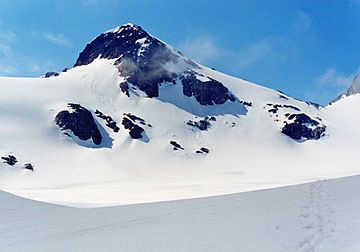Neve Peak facts for kids
Quick facts for kids Neve Peak |
|
|---|---|

Neve Peak from Colonial Glacier
|
|
| Highest point | |
| Elevation | 7,509 ft (2,289 m) |
| Prominence | 505 ft (154 m) |
| Geography | |
| Location | Whatcom County, Washington, U.S. |
| Parent range | Cascade Range |
| Topo map | USGS Diablo Dam |
Neve Peak is a tall mountain in North Cascades National Park in Washington, USA. It stands about 7,509 feet (2,289 m) high. This peak is located in the southern part of the park. It is also very close to another mountain called Colonial Peak.
Two glaciers are near Neve Peak. The Neve Glacier is just south of the peak. The Colonial Glacier flows down from its northern slopes.
Mountain Weather: Neve Peak's Climate
Neve Peak is in a special weather area called the "marine west coast climate zone." This means it gets a lot of rain and snow. Most of the weather comes from the Pacific Ocean. These weather systems travel northeast towards the Cascade Range.
When the weather fronts reach the North Cascades, the tall mountains push the air upwards. This makes the air cool down and drop its moisture. This process is called Orographic lift. It causes a lot of rain or snow to fall on the mountains. The west side of the North Cascades gets a lot of precipitation, especially in winter.
During winter, it is often cloudy. However, in summer, high pressure systems over the Pacific Ocean often bring clear skies. The snow here tends to be wet and heavy because of the ocean's influence. This can make the risk of avalanches higher. Avalanches are when large amounts of snow slide down a mountain.
How Neve Peak Was Formed: Geology
The North Cascades mountains have very rugged shapes. You can see sharp peaks, tall spires, long ridges, and deep valleys carved by glaciers. These amazing shapes were created by geological events that happened millions of years ago. These events also caused big changes in height across the Cascade Range, leading to different climates.
The Cascade Mountains started forming millions of years ago, during the late Eocene Epoch. This happened when the North American Plate slowly moved over the Pacific Plate. This movement caused many volcanic eruptions.
Also, small pieces of land, called terranes, joined together. These pieces came from both the ocean floor and larger landmasses. They helped create the North Cascades about 50 million years ago.
Later, during the Pleistocene period, which was over two million years ago, huge glaciers covered the land. These glaciers moved forward and then melted back many times. As they moved, they scraped away rock and left behind debris. The "U"-shaped valleys you see today were carved out by these ancient glaciers.
The main forces that created the tall peaks and deep valleys of the North Cascades were uplift (when the land is pushed up) and faulting (when cracks form in the Earth's crust), combined with the powerful action of glaciers.



